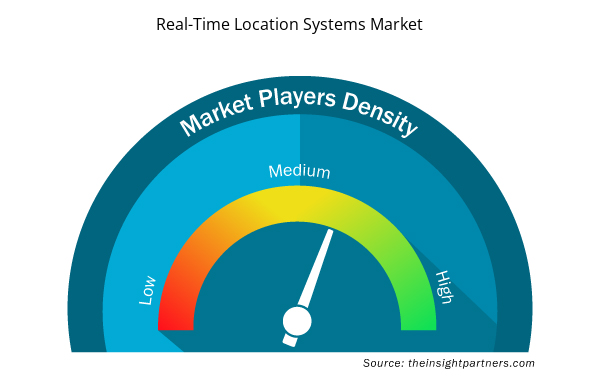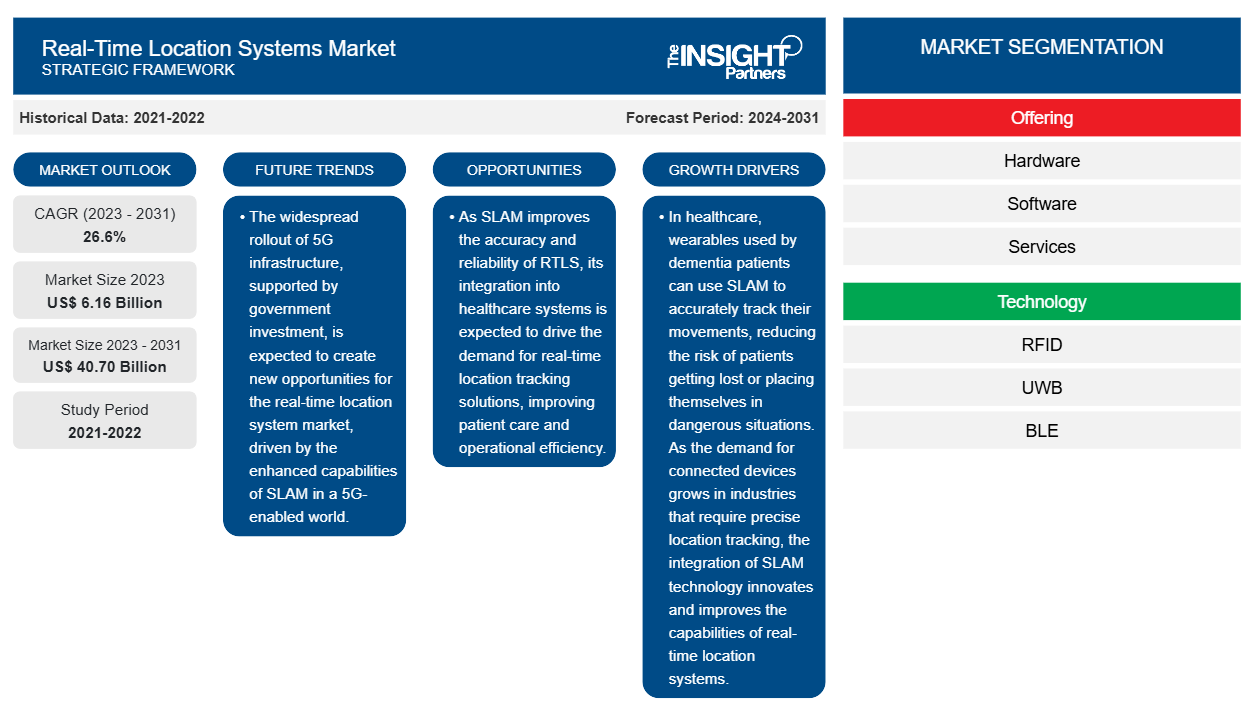リアルタイム位置情報システムの市場規模は、2023年の61億6,000万米ドルから2031年には407億米ドルに達すると予測されています。市場は2023年から2031年の間に26.6%のCAGRを記録すると予想されています。ヘルスケア分野でのRTLSの使用増加は、市場のトレンドになる可能性があります。
リアルタイム位置情報システム市場分析
スマートフォン、タブレット、スマートウォッチ、フィットネストラッカー、VRヘッドセット、ウェブ対応メガネ、スマートジュエリー、Bluetoothヘッドセットなどのさまざまなウェアラブルデバイスを含むコネクテッドデバイスの需要が世界中で高まっています。スマートフォンとタブレットは、ユーザーが位置情報をリアルタイムで正確に追跡するのに役立ちます。これらのデバイスは、ユーザーがリアルタイムの交通状況を把握し、目的地への最速ルートを見つけるのに役立ちます。また、さまざまな位置追跡アプリを通じて、親が子供の動きを監視するのにも役立ちます。そのため、スマートフォンとタブレットの採用は大幅に増加しています。Groupe Speciale Mobile Association(GSMA)によると、2022年の世界のスマートフォン採用率は76%で、スマートフォン接続数は合計64億件でした。2030年までに採用率は92%に上昇し、世界全体で90億件の接続になると予想されています。同レポートによると、北米でのスマートフォン普及率は2022年には84%で、2030年までに90%に上昇すると予想されています。同様に、ヨーロッパでのスマートフォン普及率は2022年の84%から2030年までに91%に上昇すると予想されています。普及が遅れているサハラ以南のアフリカでは、スマートフォン普及率は2022年の51%から2030年までに87%に増加すると予測されています。
リアルタイム位置情報システム市場の概要
リアルタイム ロケーション システム市場は、北米、ヨーロッパ、アジア太平洋 (APAC)、中東およびアフリカ (MEA)、南米 (SAM) の 5 つの主要地域に大まかに分かれています。2023 年には北米が最大の市場シェアを占め、ヨーロッパと APAC がそれに続きます。2023 年から 2031 年にかけて、APAC は市場で最も高い CAGR を記録すると予想されています。
インドや中国などの発展途上国におけるリアルタイムロケーションシステムの需要の増加は、予測期間中にアジア太平洋地域の市場プレーヤーに有利な機会を生み出すと予想されます。成長を続ける製造、小売、物流業界では資産追跡の必要性が高まっており、この地域でのリアルタイムロケーションシステムの需要に拍車をかけています。上記業界でのRTLSとSLAMの需要の高まりにより、市場プレーヤーは顧客に高度なソリューションを提供するよう促されています。中国国務院によると、中国では小売業界が活況を呈しており、2023年の売上高は前年比11%増の2.24兆米ドルに達する見込みです。これらの国々における高度な技術に対する需要の高まりは、APACのリアルタイムロケーションシステム市場の成長を促進すると予想されます。
要件に合わせてレポートをカスタマイズする
このレポートの一部、国レベルの分析、Excelデータパックなど、あらゆるレポートを無料でカスタマイズできます。また、スタートアップや大学向けのお得なオファーや割引もご利用いただけます。
- このレポートの主要な市場動向を入手してください。この無料サンプルには、市場動向から見積もりや予測に至るまでのデータ分析が含まれます。
リアルタイム位置情報システムの市場推進要因と機会
成長する電子商取引分野
COVID-19パンデミック以降、世界中でオンラインショッピングが急増しています。近年、eコマースの売上は大幅な成長率を記録しています。国際航空運送協会(IATA)によると、2021年には21億4千万人(世界人口の約27.6%)がオンラインポータルで商品を購入しました。さらに、アジア太平洋地域は世界のeコマース市場をリードしており、中国は地域の市場成長のかなりの部分を占めています。国際貿易局によると、中国は世界最大のeコマース市場であり、世界の取引の約50%を生み出しています。2021年、中国はeコマース部門を通じて約1.5兆米ドルの収益を生み出し、世界最大のeコマース市場となりました。また、ヨーロッパはeコマースの成長を支える重要な地域です。 Eurostatによると、2022年には欧州連合(EU)諸国の16〜74歳の人々の91%がインターネットを利用し、そのうち約75%が商品やサービスをオンラインで注文しました。また、eショッピングをする人の割合は、2012年の55%から2022年には75%に増加し、過去10年間で20%増加しました。ヨーロッパの多くの買い物客は、Amazon、Target、Walmartなどのオンラインショッピングプラットフォームを好んでおり、これがヨーロッパのeコマース部門の成長を主に推進しています。オンラインショッピングの需要の高まりにより、企業は小売業のコスト効率とスピードを向上させる必要に迫られており、サプライチェーン管理を最適化し、需要を満たす堅牢なソリューションを構築する必要性が高まっています。eコマース部門では、リアルタイムロケーションシステムが商品の監視と位置特定に役立ちます。また、配送センターの運営者に有益な洞察を提供し、推測に頼るのではなくデータに基づいた意思決定を行うことができます。
5Gの登場
5Gネットワークは4Gネットワークの約100倍の速度で、リアルタイムのデータ取得が容易になります。5Gネットワークは強力な接続性と高速データ転送を提供するため、世界中で需要が高まっています。Groupe Speciale Mobile Association(GSMA)によると、世界の5G普及率は2022年の17%から2030年には54%に達すると予想されています。北米は2022年に39%で最も高い5G普及率を示し、2030年までに91%に達すると予想されています。アジア太平洋地域(中国を除く)とヨーロッパの5G普及率は、2022年の4%と11%から、2030年にはそれぞれ41%と87%に増加すると予想されています。5Gはイノベーションを可能にし、デジタル変革をサポートできる重要な新世代ネットワーク技術であるため、世界中で需要が高まっています。そのため、さまざまな国の政府が5Gインフラに投資しています。フランス政府は2021年7月、官民投資を通じて2025年までに5G市場に約20億6,000万米ドル(17億ユーロ)を投資する計画を発表しました。これにより、政府は国内の5G開発を加速することを目指しています。同様に、韓国政府は2021年1月、次世代モバイルネットワーク、特に5Gのカバレッジを、現在の主要7都市から今年85都市に拡大すると発表しました。政府は2021年に約1億1,589万米ドル(1,279億ウォン)を投資し、プライベート5Gネットワークの使用を促進しました。5Gへの投資の増加は、接続性の向上とリアルタイムデータ(ナビゲーションから緊急サービスまで、さまざまなアプリケーションに使用できるリアルタイムの位置追跡を含む)の取得に役立ちます。したがって、5Gネットワークの出現は、予測期間中にリアルタイムロケーションシステム市場に有利な機会を生み出すと予想されます。
リアルタイムロケーションシステム市場レポートのセグメンテーション分析
リアルタイム ロケーション システム市場分析の導出に貢献した主要なセグメントは、提供、テクノロジー、業界垂直、およびアプリケーションです。
- 提供内容に基づいて、世界のリアルタイム位置情報システム市場は次のように分類されます。ハードウェア、ソフトウェア、サービス。2023年にはハードウェア部門が最大の市場シェアを占めました。
- 技術別に見ると、市場は無線周波数識別(RFID)、超広帯域(UWB)、Bluetooth Low Energy(BLE)、超音波、赤外線(IR)、全地球測位システム(GPS)、Wi-Fi、ZigBeeに分かれています。Bluetooth Low Energy(BLE)セグメントは、2023年に市場で最大のシェアを占めました。
- 業界別に見ると、市場は小売、政府および防衛、製造、ヘルスケア、物流、重工業、建設、石油およびガス、自動車、その他に分かれています。ヘルスケア部門は2023年に最大の市場シェアを占めました。
- アプリケーションに基づいて、市場は人員/スタッフの所在と監視、アクセス制御とセキュリティ、環境監視、倉庫管理と監視、サプライチェーン管理と運用の自動化/可視性、その他に分かれています。サプライチェーン管理と運用の自動化/可視性セグメントは、2023年に市場でより大きなシェアを占めました。
リアルタイム位置情報システムの地域別市場シェア分析
リアルタイム位置情報システム市場レポートの地理的範囲は、主に北米、アジア太平洋、ヨーロッパ、中東およびアフリカ、南米の 5 つの地域に分かれています。
北米は2023年に最大のリアルタイム位置情報システム市場シェアを占め、予測期間中もその優位性を維持すると予測されています。北米のリアルタイム位置情報システム市場は、米国、カナダ、メキシコに分割されています。北米は、高度なハードウェア採用の見通しが良好であること、技術革新への傾向が高いこと、GDPが高いこと、インフラが整備されていること、経済政策が有利であることなどの要因により、技術的に先進的な地域です。この地域には高度に発達した製造業があります。米国国立標準技術研究所によると、米国の製造業は2022年に2.3兆米ドルの収益を上げ、国の総GDPの11.4%を占めています。この部門は、RTLSと同時位置推定およびマッピング(SLAM)を統合して、垂直方向にわたって堅牢なサプライチェーンを維持しています。北米の小売部門は、スキャンシステムを使用してオブジェクトに取り付けられたタグからのデータ転送と詳細を容易にし、自動識別と追跡を可能にする追跡ハードウェアの主要な採用者です。国際貿易局(ITA)によると、2022年にはカナダの電子商取引ユーザーは約2,700万人で、カナダの人口の75%を占め、2025年までにその数は77.6%に達すると予想されています。2022年3月の電子商取引の売上高は約23億4,000万米ドルで、2025年までに403億米ドルに達すると予測されています。
北米には確立された医療産業があります。在庫管理業務は、いくつかの意思決定プロセスの前提条件として機能する高度なテクノロジーを使用して効率的に実行されます。この地域の病院は、効率的な在庫管理を可能にするために、病院の供給管理システムにベストプラクティスを実装することに非常に傾倒しています。彼らは、施設内の医療専門家が必要な機器をすばやく検索できるように、RTLSとSLAMを導入しています。さらに、RTLSとSLAMテクノロジーは、ICUの重篤な患者や認知症や精神的苦痛を患っている患者を追跡および監視するのに役立ちます。医療インフラにおけるこれらのテクノロジーの使用が増えていることは、リアルタイムロケーションシステム市場の成長を支えています。北米のいくつかの企業は、RTLSとSLAMの新しいテクノロジーに投資しています。たとえば、2024年9月、RTLSテクノロジーのプロバイダーであるLitumは、新生児向けに特別に設計されたLittle Tagを備えた乳児セキュリティRTLSの発売を発表しました。このテクノロジーは、医療施設での乳児の誘拐や不一致を防ぎます。
リアルタイム位置情報システム市場の地域別分析
予測期間を通じてリアルタイム ロケーション システム市場に影響を与える地域的な傾向と要因は、Insight Partners のアナリストによって徹底的に説明されています。このセクションでは、北米、ヨーロッパ、アジア太平洋、中東およびアフリカ、南米および中米にわたるリアルタイム ロケーション システム市場のセグメントと地理についても説明します。

- リアルタイムロケーションシステム市場の地域別データを入手
リアルタイムロケーションシステム市場レポートの範囲
| レポート属性 | 詳細 |
|---|---|
| 2023年の市場規模 | 61億6千万米ドル |
| 2031年までの市場規模 | 407億米ドル |
| 世界のCAGR(2023年~2031年) | 26.6% |
| 履歴データ | 2021-2022 |
| 予測期間 | 2024-2031 |
| 対象セグメント | 提供することで
|
| 対象地域と国 | 北米
|
| 市場リーダーと主要企業プロフィール |
|
市場プレーヤーの密度:ビジネスダイナミクスへの影響を理解する
リアルタイム ロケーション システム市場は、消費者の嗜好の変化、技術の進歩、製品の利点に対する認識の高まりなどの要因により、エンド ユーザーの需要が高まり、急速に成長しています。需要が高まるにつれて、企業は提供内容を拡大し、消費者のニーズを満たすために革新を起こし、新たなトレンドを活用し、市場の成長をさらに促進しています。
市場プレーヤー密度とは、特定の市場または業界内で活動している企業または会社の分布を指します。これは、特定の市場スペースに、その規模または総市場価値と比較して、どれだけの競合相手 (市場プレーヤー) が存在するかを示します。
リアルタイムロケーションシステム市場で事業を展開している主要企業は次のとおりです。
- アルバネットワークス
- 株式会社アイリスタフロー
- Qorvo 株式会社
- インピンジ株式会社
- シーメンスAG
免責事項:上記の企業は、特定の順序でランク付けされていません。

- リアルタイムロケーションシステム市場のトップキープレーヤーの概要を入手
リアルタイム位置情報システムの市場ニュースと最近の動向
リアルタイム ロケーション システム市場は、重要な企業出版物、協会データ、データベースなど、一次調査と二次調査後の定性的および定量的データを収集することによって評価されます。リアルタイム ロケーション システム市場におけるいくつかの開発を以下に示します。
- ヒューストン空港は、HPE Aruba Networking ソリューションと提携して、Wi-Fi 6E 対応の HPE Aruba Networking ソリューションを導入しました。(出典: Aruba Networking、プレスリリース、2024 年)
シーメンスと NVIDIA は、NVIDIA Omniverse Cloud API を活用してシーメンス Xcelerator プラットフォーム上で没入型の視覚化を実現し、AI 主導のデジタル ツイン テクノロジーの可能性を実証する産業用メタバースを共同で作成しました。(出典: シーメンス、プレス リリース、2024 年)
Slamcore は最新の SDK 23.04 をリリースしました。この SDK には Perceive 機能が含まれており、エッジ AI およびロボティクス向けの NVIDIA Jetson Orin ファミリの組み込みシステムをサポートし、自律移動ロボットのビジョン統合を加速することを目指しています。(出典: Slamcore、プレスリリース、2023 年)
リアルタイムロケーションシステム市場レポートの対象範囲と成果物
「リアルタイム位置情報システム市場の規模と予測(2021~2031年)」レポートでは、以下の分野をカバーする市場の詳細な分析を提供しています。
- リアルタイム位置情報システムの市場規模と予測(対象範囲に含まれるすべての主要市場セグメントについて、世界、地域、国レベルで)
- リアルタイム位置情報システムの市場動向、および推進要因、制約、主要な機会などの市場動向
- 詳細なPESTおよびSWOT分析
- 主要な市場動向、世界および地域の枠組み、主要プレーヤー、規制、最近の市場動向を網羅したリアルタイム位置情報システム市場分析
- リアルタイム位置情報システム市場の市場集中、ヒートマップ分析、主要プレーヤー、最近の動向を網羅した業界展望と競争分析
- 詳細な企業プロフィール
- 過去2年間の分析、基準年、CAGRによる予測(7年間)
- PEST分析とSWOT分析
- 市場規模価値/数量 - 世界、地域、国
- 業界と競争環境
- Excel データセット


- Batter and Breader Premixes Market
- Webbing Market
- Artificial Intelligence in Healthcare Diagnosis Market
- Grant Management Software Market
- Digital Pathology Market
- Blood Collection Devices Market
- Water Pipeline Leak Detection System Market
- Travel Vaccines Market
- Radiopharmaceuticals Market
- Broth Market

Report Coverage
Revenue forecast, Company Analysis, Industry landscape, Growth factors, and Trends

Segment Covered
This text is related
to segments covered.

Regional Scope
North America, Europe, Asia Pacific, Middle East & Africa, South & Central America

Country Scope
This text is related
to country scope.
よくある質問
Growing use of RTLS in healthcare sector is expected to drive the growth of the real-time location systems market in the coming years.
The real-time location systems market is expected to reach US$ 40.70 million by 2031.
The key players operating in the real-time location systems market include Aruba Networks, AiRISTA Flow Inc, Qorvo Inc, Impinj Inc, Siemens AG, Zebra Technologies Corp, Sonitor Technologies AS, Stanley Black & Decker Inc, TeleTracking Technologies Inc, Ubisense Ltd, Slamcore Ltd, Kudan Inc, Microsoft Corp, Sevensense Robotics AG, and NavVis GmbH.
The hardware segment led the real-time location systems market with a significant share in 2023.
The real-time location systems market was estimated to be valued at US$ 6.16 billion in 2023 and is anticipated to grow at a CAGR of 26.6% over the forecast period.
The demand for connected devices, including smartphones, tablets, and different wearable devices, such as smartwatches, fitness trackers, VR headsets, web-enabled glasses, smart jewelry, and Bluetooth headsets, is increasing across the world. As the demand for connected devices grows in industries that require precise location tracking, the integration of SLAM technology innovates and improves the capabilities of real-time location systems.
Asia Pacific is anticipated to grow at the fastest CAGR over the forecast period.
Trends and growth analysis reports related to Electronics and Semiconductor : READ MORE..
The List of Companies - Real-Time Location Systems Market
- Aruba Networks
- AiRISTA Flow Inc
- Qorvo Inc
- Impinj Inc
- Siemens AG
- Zebra Technologies Corp
- Sonitor Technologies AS
- Stanley Black & Decker Inc
- TeleTracking Technologies Inc
- Ubisense Ltd
- Slamcore Ltd
- Kudan Inc
- Microsoft Corp
- Sevensense Robotics AG
- NavVis GmbH
The Insight Partners performs research in 4 major stages: Data Collection & Secondary Research, Primary Research, Data Analysis and Data Triangulation & Final Review.
- Data Collection and Secondary Research:
As a market research and consulting firm operating from a decade, we have published and advised several client across the globe. First step for any study will start with an assessment of currently available data and insights from existing reports. Further, historical and current market information is collected from Investor Presentations, Annual Reports, SEC Filings, etc., and other information related to company’s performance and market positioning are gathered from Paid Databases (Factiva, Hoovers, and Reuters) and various other publications available in public domain.
Several associations trade associates, technical forums, institutes, societies and organization are accessed to gain technical as well as market related insights through their publications such as research papers, blogs and press releases related to the studies are referred to get cues about the market. Further, white papers, journals, magazines, and other news articles published in last 3 years are scrutinized and analyzed to understand the current market trends.
- Primary Research:
The primarily interview analysis comprise of data obtained from industry participants interview and answers to survey questions gathered by in-house primary team.
For primary research, interviews are conducted with industry experts/CEOs/Marketing Managers/VPs/Subject Matter Experts from both demand and supply side to get a 360-degree view of the market. The primary team conducts several interviews based on the complexity of the markets to understand the various market trends and dynamics which makes research more credible and precise.
A typical research interview fulfils the following functions:
- Provides first-hand information on the market size, market trends, growth trends, competitive landscape, and outlook
- Validates and strengthens in-house secondary research findings
- Develops the analysis team’s expertise and market understanding
Primary research involves email interactions and telephone interviews for each market, category, segment, and sub-segment across geographies. The participants who typically take part in such a process include, but are not limited to:
- Industry participants: VPs, business development managers, market intelligence managers and national sales managers
- Outside experts: Valuation experts, research analysts and key opinion leaders specializing in the electronics and semiconductor industry.
Below is the breakup of our primary respondents by company, designation, and region:

Once we receive the confirmation from primary research sources or primary respondents, we finalize the base year market estimation and forecast the data as per the macroeconomic and microeconomic factors assessed during data collection.
- Data Analysis:
Once data is validated through both secondary as well as primary respondents, we finalize the market estimations by hypothesis formulation and factor analysis at regional and country level.
- Macro-Economic Factor Analysis:
We analyse macroeconomic indicators such the gross domestic product (GDP), increase in the demand for goods and services across industries, technological advancement, regional economic growth, governmental policies, the influence of COVID-19, PEST analysis, and other aspects. This analysis aids in setting benchmarks for various nations/regions and approximating market splits. Additionally, the general trend of the aforementioned components aid in determining the market's development possibilities.
- Country Level Data:
Various factors that are especially aligned to the country are taken into account to determine the market size for a certain area and country, including the presence of vendors, such as headquarters and offices, the country's GDP, demand patterns, and industry growth. To comprehend the market dynamics for the nation, a number of growth variables, inhibitors, application areas, and current market trends are researched. The aforementioned elements aid in determining the country's overall market's growth potential.
- Company Profile:
The “Table of Contents” is formulated by listing and analyzing more than 25 - 30 companies operating in the market ecosystem across geographies. However, we profile only 10 companies as a standard practice in our syndicate reports. These 10 companies comprise leading, emerging, and regional players. Nonetheless, our analysis is not restricted to the 10 listed companies, we also analyze other companies present in the market to develop a holistic view and understand the prevailing trends. The “Company Profiles” section in the report covers key facts, business description, products & services, financial information, SWOT analysis, and key developments. The financial information presented is extracted from the annual reports and official documents of the publicly listed companies. Upon collecting the information for the sections of respective companies, we verify them via various primary sources and then compile the data in respective company profiles. The company level information helps us in deriving the base number as well as in forecasting the market size.
- Developing Base Number:
Aggregation of sales statistics (2020-2022) and macro-economic factor, and other secondary and primary research insights are utilized to arrive at base number and related market shares for 2022. The data gaps are identified in this step and relevant market data is analyzed, collected from paid primary interviews or databases. On finalizing the base year market size, forecasts are developed on the basis of macro-economic, industry and market growth factors and company level analysis.
- Data Triangulation and Final Review:
The market findings and base year market size calculations are validated from supply as well as demand side. Demand side validations are based on macro-economic factor analysis and benchmarks for respective regions and countries. In case of supply side validations, revenues of major companies are estimated (in case not available) based on industry benchmark, approximate number of employees, product portfolio, and primary interviews revenues are gathered. Further revenue from target product/service segment is assessed to avoid overshooting of market statistics. In case of heavy deviations between supply and demand side values, all thes steps are repeated to achieve synchronization.
We follow an iterative model, wherein we share our research findings with Subject Matter Experts (SME’s) and Key Opinion Leaders (KOLs) until consensus view of the market is not formulated – this model negates any drastic deviation in the opinions of experts. Only validated and universally acceptable research findings are quoted in our reports.
We have important check points that we use to validate our research findings – which we call – data triangulation, where we validate the information, we generate from secondary sources with primary interviews and then we re-validate with our internal data bases and Subject matter experts. This comprehensive model enables us to deliver high quality, reliable data in shortest possible time.


 このレポートの無料サンプルを入手する
このレポートの無料サンプルを入手する